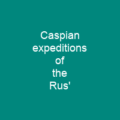The Caspian Expeditions of the Rus’: A Tale of Trade, Raiding, and Power
Imagine a time when the mighty Rus’ ventured far beyond their lands along the Volga River, embarking on daring expeditions to the shores of the Caspian Sea. These were not just simple trading missions but military raids that would shape the history of the region for centuries. Who could have predicted that these early ventures would lead to such significant events?
The Early Days: Merchants Turned Raiders
In the late 9th century, the Rus’ appeared as merchants along the Volga trade route, selling furs, honey, and slaves. But as time passed, something changed. The first large-scale Viking raids began in the late 9th and early 10th centuries, with the first recorded raid occurring in 909 or 910. What triggered this transformation from peaceful traders to fierce warriors?
The First Major Raids
In 913, a fleet of 500 ships reached the Caspian Sea shores through the Khazar country, leading to pillaging in the Gorgan region, Gilan, and Mazandaran. The Rus’ then launched subsequent raids, capturing Bardha’a and destroying the Khazar state in 965 under Sviatoslav’s command. Was it just about plunder or was there a deeper motive?
The Conflict with Khazaria
The conflict between Khazaria and Rus’ is unclear, but possibilities include economic competition or other factors contributing to the destruction of Khazaria. The Rus’ sought to remove Khazar control on the Volga trade route due to duties and Byzantine influence. Was it a simple case of business rivalry, or was there more at stake?
The Sviatoslav Campaign
In 965, Sviatoslav I of Kiev led a successful campaign against Khazaria, destroying cities such as Sarkel and Atil. The destruction of Khazar power paved the way for Kievan Rus’ dominance over trade routes. How did this impact the region’s economy and politics?
Later Expeditions
Later expeditions included helping Maymun emir of Derbent in 987-1032, with varying degrees of success. In 1042 Ingvar the Far-Travelled led a failed Viking attack on Persia with 200 ships. What drove these later ventures? Were they purely for plunder or did they serve other purposes?
The Ingvar Expedition
A similar expedition in 1041 was launched by Ingvar, who sailed down the Volga into Saracen lands. He went east for gold but died there. Twenty-six Ingvar Runestones were found in Sweden, referring to Swedish warriors who accompanied him. However, no attempts were made after his death to reopen trade routes between the Baltic and Caspian seas. What lessons can we draw from these failed endeavors?
The Legacy of the Caspian Expeditions
The legacy of the Caspian expeditions is complex, involving not just military conquests but also economic and cultural exchanges. The Rus’ raids had a profound impact on the region’s history, shaping trade routes and political alliances. How do these events resonate in today’s world?

The story of the Caspian expeditions is a reminder that history often unfolds in unexpected ways. From peaceful traders to fierce warriors, the journey of the Rus’ across the Caspian Sea offers valuable insights into the dynamics of power and trade in medieval times. As we look back on these events, we can see how they laid the groundwork for future developments in the region.
You want to know more about Caspian expeditions of the Rus?
This page is based on the article Caspian expeditions of the Rus published in Wikipedia (retrieved on March 11, 2025) and was automatically summarized using artificial intelligence.







